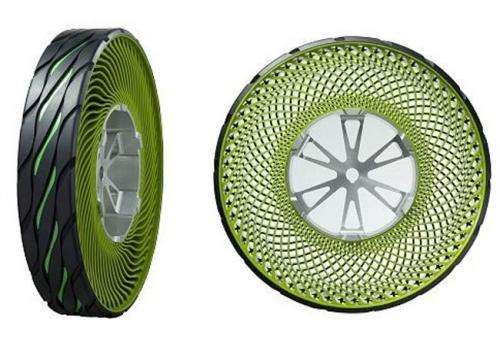(PhysOrg.com) -- Visitors to the 42nd Tokyo Motor Show are to witness a new breed of airless tires from Bridgestone. Interest in the general press is already humming because of the material, design, and features of the Bridgestone debut on show. The concept tires use recycled thermoplastic, outside tread included. Fittingly colored green, the tires are being promoted for their green advantage of being completely recyclable.
The spokes are made of reusable thermoplastic resin. In design, interest is drawn toward the thermoplastic fins, staggered so that connections to the hub and the rim do not torque and there is no structural breakdown. The tires’ resin spokes radiate from rim to tread. They curve to the left and right to support vehicle loads.
Bridgestone is not the first to experiment with an airless tire concept. Observers point to Michelin’s debut in 2005 of its airless Tweel tires. These were seen with much interest as a novel departure from the traditional wheel hub assembly, though concerns were raised in some quarters about their being noisy and vibrations at high speeds. The name Tweel is a combination of the words tire and wheel. Michelin used polyurethane spokes arrayed in a wedge pattern.
In describing differences between the Michelin and Bridgestone concept, observers say a key contrast is in size of the ribs. Michelin’s tires were viewed as more suitable for military applications—this is not like the Bridgestone concept, which is suited for something more consumer-driven.
Another tire concept innovator has been Yokohama Rubber Co. Ltd. The company announced in October this year its airless tire concept which relies on mechanical rather than pneumatic support. Yokohama introduced its tire concept earlier this year at a design expo in Japan.
Bridgestone’s airless tires have a deeper structure of plastic ribs than either of the other two approaches, and it has a higher aspect ratio, according to Plastics News.
Obviously, the key benefit for the consumer will be seen in the fact that the Bridgestone tires cannot suffer punctures. On the other hand, these have a way to go before seeing car commercialization.
The tires are in prototype stage only and due for further evaluations. The company has tested the tires, nine inches across, on single seater electric carts in Japan.
Observers see similar uses, at this earlier level, as potential for use in motorized golf carts, lawnmowers and vehicles for the elderly.
© 2011 PhysOrg.com




















